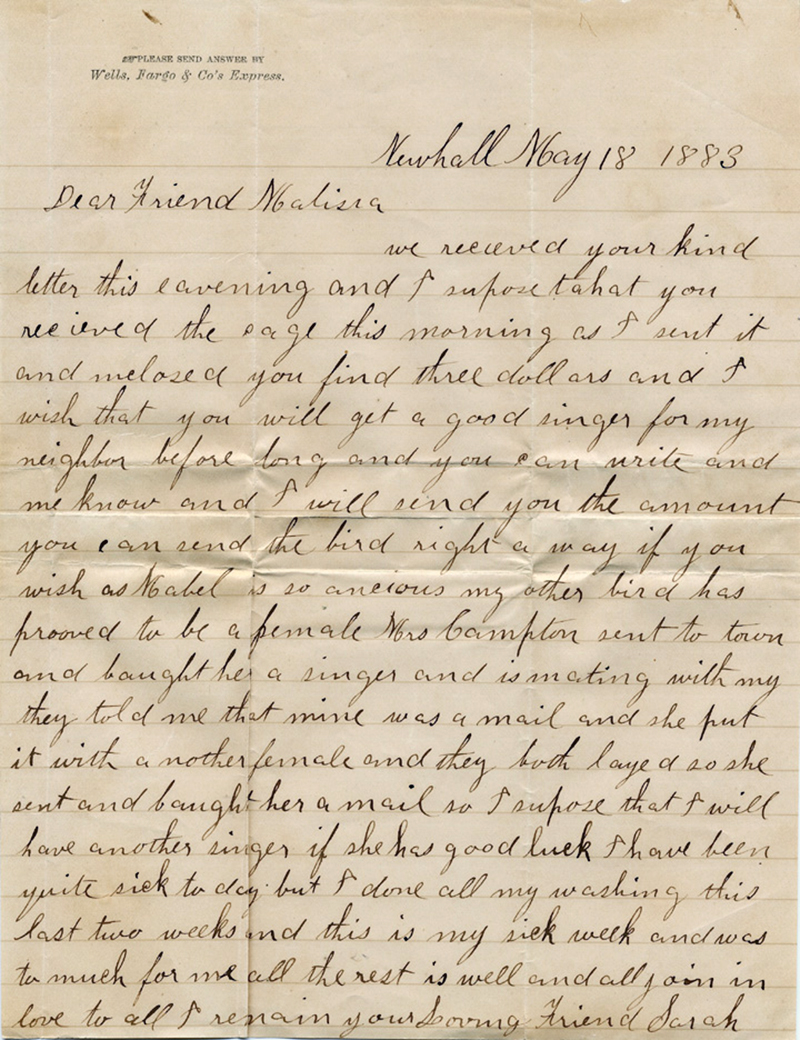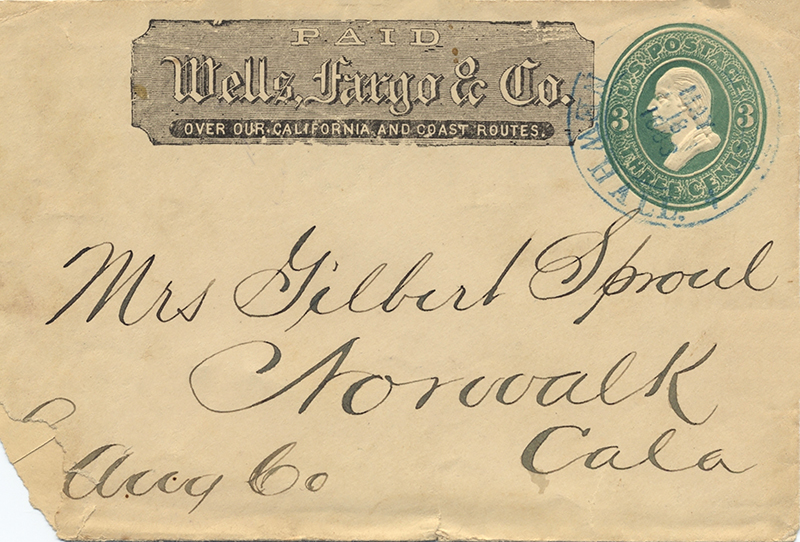|
|


Wells, Fargo & Co. Express letter and envelope addressed to Mrs. Gilbert Sproul, dated and postmarked Newhall, May 18, 1883. The Wells, Fargo Express office was located inside the SPRR Newhall Depot. Letter reads:
Newhall May 18 1883.
Dear Friend Malissa We received your kind letter this evening and I suppose that you recieved the page this morning as I sent it and enclosed you find three dollars and I wish that you will get a good singer for my neighbor before long and you can write and me know and I will send you the amount you can send the bird right a way if you wish as Mabel is so anxious my other bird has prooved [sic] to be a female Mrs Campton [George Campton's wife, Gregeria?] sent to town and bought her a singer and is mating with my they told me that mine was a mail [sic] and she put it with another female and they both layed so she sent and bought her a mail so I supose that I will have another singer if she has good luck I have been quite sick today but I done all my washing this last two weeks and this is my sick week and was to much for me all the rest is well and all join in love to all I remain your
Loving Friend Sarah The "Friend" reference would seem to imply they were Quakers. What we do know is that Mrs. Gilbert Sproul was Anne M. Sproul. Her husband, Gilbert Sproul, was the founder of the city of Norwalk, California. In 1869, Gilbert and his brother Atwood Sproul, both from Oregon, purchased 463 acres of land in Southern California in an area called Corazon de los Valles, or "Heart of the Valleys." When railroads reached the area in 1873, Gilbert surveyed a town site which was officially recorded as Norwalk in 1874. This letter is written by an unknown person named Sarah to her friend Malissa. We can only speculate who Malissa was, but since the envelope is addressed to Mrs. Sproul, is it possible that Malissa could be the middle name of Anne M. Sproul? Apparently Sarah was not big on punctuation. Wells, Fargo is an iconic name associated with a vast empire of stagecoaches and mail delivery in the Old West. This letter and envelope show us that Wells Fargo indeed had a presence in Newhall, California in the 1880s. The discovery of these Wells Fargo items conjures up romantic visions of Wells Fargo stages crossing over Beale's Cut to deliver mail to the town of Newhall. We can only speculate on this however, as we have not come across any photographs of Wells Fargo stagecoaches in the Santa Clarita Valley of the 19th century.
About Wells, Fargo & Co. Wells, Fargo & Co. was founded March 18, 1852, and opened its first office in San Francisco in July 1852. After the financial Panic of 1855, the company expanded rapidly and by 1866 was the West's leading agent for business, communications, and transportation. They operated the Overland mail route from the Missouri River to the Pacific Ocean, and ran most of the stagecoach lines in the West. Wells, Fargo was the banker and primary lender for John Butterfield's Overland Mail route which ran stagecoaches between St. Louis and California (with several stations in the Santa Clarita Valley) from 1858 until the beginning of the Civil War. Wells, Fargo took over and operated the western portion of the Pony Express from Salt Lake City to San Francisco when the original operators Russell, Majors, and Waddell ran into financial trouble in 1861. Ben Holladay subsequently acquired Russell, Majors, and Waddell and became a major competitor with Wells Fargo, establishing stagecoach lines in eight western states. In 1866, Wells Fargo bought out Holladay's operations to become the leading stagecoach empire in the Western United States. However, with the completion of the transcontinental railroad in May 1869, the stagecoach business was greatly diminished. In spite of the railroad competition, Wells Fargo survived and greatly expanded its banking and express offices, which numbered 3500 by the turn of the century. The last Wells Fargo stagecoach ran between Tonopah and Manhattan, Nevada, in 1909. Wells Fargo remains to this day a major banking operation in 21st-century America.
AL1883: 9600 dpi jpeg from original letter and envelope in the collection of Dr. Alan Pollack.
|
The site owner makes no assertions as to ownership of any original copyrights to digitized images. However, these images are intended for Personal or Research use only. Any other kind of use, including but not limited to commercial or scholarly publication in any medium or format, public exhibition, or use online or in a web site, may be subject to additional restrictions including but not limited to the copyrights held by parties other than the site owner. USERS ARE SOLELY RESPONSIBLE for determining the existence of such rights and for obtaining any permissions and/or paying associated fees necessary for the proposed use.






